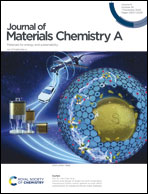Uniphase ruthenium–iridium alloy-based electronic regulation for electronic structure–function study in methane oxidation to methanol †
Abstract
For the first time, we synthesize uniphase face-centered-cubic (fcc) structured Ru–Ir alloy nanoparticles (NPs) with a uniform size of ∼2 nm over the whole composition range, using RuCl3 and IrCl4 as precursors. The electronic structure of Ir is gradually tuned by varying the composition. The consistency of the fcc structure of Ru and Ir within the RuxIr1−x alloys allows better study of the electronic structure–activity relationship without introducing unnecessary factors such as the lattice/phase effect in the case of the RuIr alloy composed of different structures of hcp-Ru and fcc-Ir. The obtained RuxIr1−x alloys were further employed as precursors for the synthesis of their corresponding oxides, RuxIr1−xO2/CuO, to probe the electronic structure–activity relationship in the methane oxidation to methanol reaction. The electronic structure of Ir4+ was able to be regulated by tuning the composition of the RuxIr1−x NP precursors. The optimum catalytic behavior was achieved over Ru0.5Ir0.5O2/CuO, where both Ru and Ir reached the highest electrophilic state, at which point the C–H cleavage capacity also reached the maximum as observed by CH4-TPR.



 Please wait while we load your content...
Please wait while we load your content...